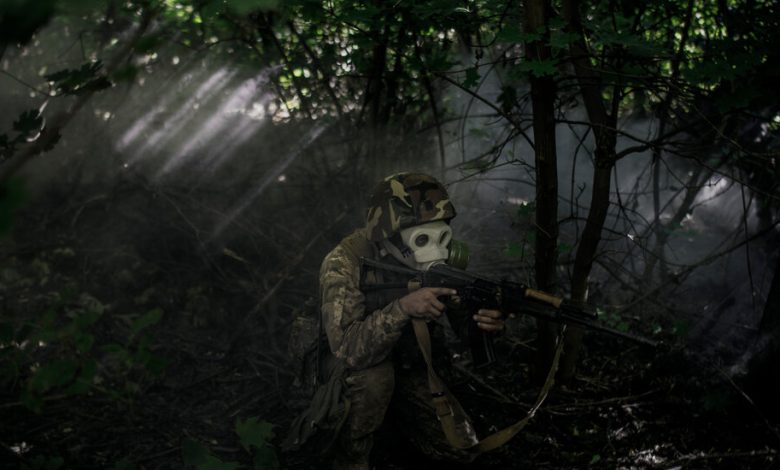‘It’s Not a Sprint,’ Ukraine’s Marines Insist. ‘It’s a Marathon.’

They have NATO equipment and Western training. Some have English-speaking commanders, unusual in the Ukrainian military, and even an American-accented, evangelical chaplain.
“I am never tired, I’m in the Ukrainian marines,” joked Oleksandr, 28, a battalion commander of the 37th Marine Brigade. Sitting down in the shade outside a cottage near the front line, he was determinedly positive. “I think it’s going well.”
Over the past several months, nine Ukrainian brigades, 36,000 troops in all, have received four to six weeks of training in combined arms combat, a synchronized way of fighting that some thought would enable them to spearhead another rout of the Russian military, as in Kharkiv last year.
But some brigades suffered heavy losses in the initial stages of this summer’s counteroffensive, struggling to advance against the formidable Russian defenses. At least one new brigade was so badly debilitated from casualties that it was withdrawn from the battlefield to rebuild.

Ukrainian troops near the southern front line.Credit…Diego Ibarra Sánchez for The New York Times
Most of the fighting has been hidden from the view of the news media since the start of operations in early June. But reporters from The New York Times were permitted to visit several marine brigades — two of them newly formed brigades — that are operating on one part of the southern front to hear from the troops themselves about their role in the counteroffensive.
Ukraine’s new brigades, trained and equipped according to NATO standards, have a different look and feel from many other Ukrainian units. These marines now carry American M4 assault rifles and drive Humvees, which they repainted, changing the desert brown of the vehicles so often seen in Afghanistan and Iraq to a deep green for better cover in Ukraine’s lush countryside.
“I did not expect we would switch to NATO weapons so soon,” said Ukrop, 23, a company commander in the 38th Marine Brigade who, like all the marines interviewed for this article, gave only first names or call signs, in keeping with military protocol. He watched as men from his unit loaded two laser-guided rockets into a launcher on the back of a Humvee for a firing mission. “It’s a great new system and we have new vehicles too,” he added.
The new brigades are made up of recruits, fresh from basic training after they were called up or volunteered to join the military this year. Their commanders are mostly experienced fighters, and some, like Oleksandr, a lieutenant colonel, who has completed officer training in the United States, are career officers.
They all have a strong sense of urgency — “We have to do this fast,” one said — but they also warned that the fight would be long and hard.
“A lot of people thought it would be very fast and in the autumn we would be in Crimea,” said Oleksandr, the battalion commander. “But every meter of the tree line is very difficult.”
“It’s not a sprint,” he added. “It’s a marathon.”
The Ukrainian military does not release numbers of dead and wounded, but Oleksandr acknowledged that his brigade had taken heavy casualties in the first days of the counteroffensive in June, when his troops ran into minefields and came under an onslaught of Russian artillery and airstrikes. He did not dwell on the fighting, but he said that for many of his troops it was their first time in battle and a brutal introduction.
“I lost a lot,” he said, “and some of the new guys are mentally broken.” As for the destruction of tanks and armored vehicles, he shrugged it off as a normal consequence of war.
Those heavy early losses led to public recriminations in Ukraine, most notably from a popular soldier and blogger, Valerii Markus, who wrote a Facebook post accusing his superior officers of incompetence and of a careless disregard for the morale of the soldiers.
Ukraine’s top commander, Gen. Valery Zaluzhny, also spoke out, chiding NATO allies for expecting Ukraine to succeed in an operation without air superiority, something that they would never have contemplated attempting themselves.
Soldiers along the front line blamed commanders for pushing raw recruits into battle and using untested units to spearhead the counteroffensive. Others criticized the inadequacy of a few weeks of basic training in various NATO countries. A few complained that some of the Western vehicles were inappropriate for the task. In particular, they pointed to American MaxxPros, armored vehicles that were designed for fighting a counterinsurgency rather than facing the firepower of the Russian Army.
Oleksandr said he had often argued with his trainers in the United States. “They fought in Afghanistan and Iraq, and the enemy there is not like the Russians,” he said.
But Ukrainian officials said that they had little choice but to train recruits because their experienced troops were so thinly stretched along the front line that they could not afford to withdraw them.
The marines were careful not to judge the performance of others in the opening assaults of the counteroffensive.
“You can get disoriented in battle,” Ukrop said. “You can panic. People make mistakes.” The Ukrainian forces may also have been short-handed, he said.
The heavy losses were not a shock to them. Most of the commanders said that they had seen units, including their own, decimated at times during the past 16 months of fighting. The battalion commander, Oleksandr, said that casualties were so high during the counteroffensive in Kherson last year that he had been forced to replace the members of his unit three times.
While the Ukrainian military was training the new brigades and obtaining new equipment, the Russian forces had months to prepare a layered defense, digging in and laying extensive minefields. They also had the advantage of greater artillery fire and troop numbers, Oleksandr said.
The marines said that they were grateful for the various Western armored vehicles, which they said saved lives and were superior to the outdated Soviet-era tanks and armored vehicles that they had been using. But above all, commanders were taking care to give further training to new recruits and making sure that they were mixed in with more experienced marines for operations.
“You cannot be completely prepared for combat however much you train,” said Shturval, 52, who was overseeing training for a group of recruits brought in to make up for recent losses in the 35th Marine Brigade. “In the first fight, they go in with our veterans, and after two or three battles they are veterans themselves.”
Planning and reconnaissance was the key, said Prophet, 22, a company commander from the 38th brigade who had just led a successful assault, seizing control of three tree lines in a combined operation on the southern front.
The Russian forces were so tied up with battling other Ukrainian units on one flank that his troops were able to seize territory with minimum losses, he said.
“Our commanders are taking a very considered approach,” said his deputy brigade commander, a lieutenant colonel who uses the call sign Consul. “You cannot underestimate the enemy,” he said. “The enemy is strong and cunning. So this counteroffensive requires steady preparation.”
He said it had been wrong to think that the counteroffensive would be swift and easy, adding that when the military commanders found a weakness where they could push through, they would.
“Bit by bit, we will find a place where the seam will split open,” Consul said. “Water cuts through stone, and we’ll do the same, bit by bit. At first it is a small stream and then it turns into a river.”





